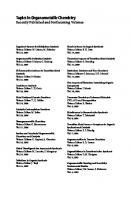Advances in Organometallic Chemistry, Vol. 17: Catalysis and Organic Syntheses 0120311178, 9780120311170, 9780080580180
285 77 251KB
English Pages 522 [525] Year 1979
Table of contents :
Front Cover......Page 1
Catalysis and Organic Syntheses......Page 4
Copyright Page......Page 5
Contents......Page 6
List of Contributors......Page 10
Preface......Page 12
I. Introduction......Page 14
II. Commercial Utilization......Page 15
III. Reaction Mechanism......Page 16
IV. Secondary Products and Reactions......Page 23
V. Substrates......Page 28
VI. Catalyst Separation and Recycle......Page 59
VII. Heterogeneous Catalysts......Page 60
VIII. Catalysts Other than Cobalt and Rhodium......Page 66
References......Page 70
I. Introduction......Page 74
II. Fischer-Tropsch Related Organometallic Chemistry......Page 79
III. Possible Mechanisms for the Fischer-Tropsch Reaction......Page 99
IV. New Technology......Page 109
V. Summary......Page 112
References......Page 113
I. Introduction......Page 118
II. Methods of Preparation and Some Features of Nickel Catalysts Active for the Oligomerization of Olefins and Related Reactions......Page 120
III. Formation and Probable Structure of the Catalytically Active Species......Page 127
IV. Examples of Selectivity Control......Page 132
References......Page 150
I. Comparison Of Nickel- and Palladium-Catalyzed Reactions Of Butadiene......Page 154
II. Catalytic Species......Page 159
III. Dimerization of Butadiene......Page 161
IV. Telomerization of Butadiene......Page 164
V. Dimerization and Telomerization of Isoprene......Page 181
VI. Cyclization Reactions......Page 189
VII. Reactions of Carbon Dioxide......Page 191
VIII. Cooligomerization of Butadiene with Olefins......Page 192
IX. Oxidative Reactions of Butadiene With Pd2+ Salts......Page 194
XI. Application of the Telomerization of Butadiene to Natural Product Synthesis......Page 195
References......Page 202
I. Introduction......Page 208
II. Carbon-Carbon Bond Formation......Page 211
III. Formation of Bonds Other Than Carbon-Carbon......Page 247
References......Page 256
I. Introduction......Page 268
II. The Carbonylation of Methanol Catalyzed by Rhodium Complexes in Solution......Page 270
III. Supported Rhodium Carbonylation Catalysts for Methanol Carbonylation......Page 275
IV. Iridium-Catalyzed Methanol Carbonylation......Page 277
References......Page 280
I. Introduction......Page 282
II. The Rhodium Catalyst System......Page 284
III. Ni-Based Catalyst System......Page 304
IV. Co and Fe Catalyst System......Page 322
V. Pd-Based Catalyst System......Page 328
References......Page 329
I. Introduction......Page 332
II. Recent Studies of Catalyst Systems Discovered Prior to 1971......Page 334
III. Asymmetric Hydrogenation......Page 351
IV. Supported Transition Metal Complexes as Catalysts......Page 374
V. Membrane Systems, Phase-Transfer Catalysis, Molten Salt Systems......Page 380
VI. Transition Metal Clusters, Including Dimers......Page 381
VII. Hydrogenation of Aromatic Hydrocarbons......Page 389
VIII. Photacatalysis......Page 391
IX. Hydrogenase Systems......Page 393
X. Hydrogen Transfer from Solvents......Page 394
XI. Miscellaneous New Catalysts......Page 396
XII. Summary......Page 401
References......Page 403
I. Introduction......Page 420
II. Chloroplatinic Acid as a Homogeneous Catalyst......Page 422
III. Homogeneous Catalysis with Metals Other Than Platinum......Page 441
IV. Effects of the Structure of the Silane......Page 447
V. Studies with Conjugated Dienes......Page 454
VI. Hydrosilation of Acetylenes......Page 456
References......Page 458
I. Introduction......Page 462
II. Origins of Carbene-Metal Complexes......Page 464
III. Cyclopropanation......Page 472
IV. Stereochemical Aspects of the Olefin Metathesis Reaction......Page 481
V. Metathesis of Substrates Bearing Polar Groups......Page 495
References......Page 502
Subject Index......Page 506
Cumulative List of Contributors......Page 520
Cumulative List of Titles......Page 522
Front Cover......Page 1
Catalysis and Organic Syntheses......Page 4
Copyright Page......Page 5
Contents......Page 6
List of Contributors......Page 10
Preface......Page 12
I. Introduction......Page 14
II. Commercial Utilization......Page 15
III. Reaction Mechanism......Page 16
IV. Secondary Products and Reactions......Page 23
V. Substrates......Page 28
VI. Catalyst Separation and Recycle......Page 59
VII. Heterogeneous Catalysts......Page 60
VIII. Catalysts Other than Cobalt and Rhodium......Page 66
References......Page 70
I. Introduction......Page 74
II. Fischer-Tropsch Related Organometallic Chemistry......Page 79
III. Possible Mechanisms for the Fischer-Tropsch Reaction......Page 99
IV. New Technology......Page 109
V. Summary......Page 112
References......Page 113
I. Introduction......Page 118
II. Methods of Preparation and Some Features of Nickel Catalysts Active for the Oligomerization of Olefins and Related Reactions......Page 120
III. Formation and Probable Structure of the Catalytically Active Species......Page 127
IV. Examples of Selectivity Control......Page 132
References......Page 150
I. Comparison Of Nickel- and Palladium-Catalyzed Reactions Of Butadiene......Page 154
II. Catalytic Species......Page 159
III. Dimerization of Butadiene......Page 161
IV. Telomerization of Butadiene......Page 164
V. Dimerization and Telomerization of Isoprene......Page 181
VI. Cyclization Reactions......Page 189
VII. Reactions of Carbon Dioxide......Page 191
VIII. Cooligomerization of Butadiene with Olefins......Page 192
IX. Oxidative Reactions of Butadiene With Pd2+ Salts......Page 194
XI. Application of the Telomerization of Butadiene to Natural Product Synthesis......Page 195
References......Page 202
I. Introduction......Page 208
II. Carbon-Carbon Bond Formation......Page 211
III. Formation of Bonds Other Than Carbon-Carbon......Page 247
References......Page 256
I. Introduction......Page 268
II. The Carbonylation of Methanol Catalyzed by Rhodium Complexes in Solution......Page 270
III. Supported Rhodium Carbonylation Catalysts for Methanol Carbonylation......Page 275
IV. Iridium-Catalyzed Methanol Carbonylation......Page 277
References......Page 280
I. Introduction......Page 282
II. The Rhodium Catalyst System......Page 284
III. Ni-Based Catalyst System......Page 304
IV. Co and Fe Catalyst System......Page 322
V. Pd-Based Catalyst System......Page 328
References......Page 329
I. Introduction......Page 332
II. Recent Studies of Catalyst Systems Discovered Prior to 1971......Page 334
III. Asymmetric Hydrogenation......Page 351
IV. Supported Transition Metal Complexes as Catalysts......Page 374
V. Membrane Systems, Phase-Transfer Catalysis, Molten Salt Systems......Page 380
VI. Transition Metal Clusters, Including Dimers......Page 381
VII. Hydrogenation of Aromatic Hydrocarbons......Page 389
VIII. Photacatalysis......Page 391
IX. Hydrogenase Systems......Page 393
X. Hydrogen Transfer from Solvents......Page 394
XI. Miscellaneous New Catalysts......Page 396
XII. Summary......Page 401
References......Page 403
I. Introduction......Page 420
II. Chloroplatinic Acid as a Homogeneous Catalyst......Page 422
III. Homogeneous Catalysis with Metals Other Than Platinum......Page 441
IV. Effects of the Structure of the Silane......Page 447
V. Studies with Conjugated Dienes......Page 454
VI. Hydrosilation of Acetylenes......Page 456
References......Page 458
I. Introduction......Page 462
II. Origins of Carbene-Metal Complexes......Page 464
III. Cyclopropanation......Page 472
IV. Stereochemical Aspects of the Olefin Metathesis Reaction......Page 481
V. Metathesis of Substrates Bearing Polar Groups......Page 495
References......Page 502
Subject Index......Page 506
Cumulative List of Contributors......Page 520
Cumulative List of Titles......Page 522


![Organic Syntheses [Volume 17]](https://ebin.pub/img/200x200/organic-syntheses-volume-17.jpg)

![Organic Syntheses: Vol. III [vol 3]](https://ebin.pub/img/200x200/organic-syntheses-vol-iii-vol-3.jpg)
![Organic Syntheses: Vol. IV [vol 4]](https://ebin.pub/img/200x200/organic-syntheses-vol-iv-vol-4.jpg)
![Topics in Organometallic Chem. Palladium in Organic Synthesis [Vol 14]](https://ebin.pub/img/200x200/topics-in-organometallic-chem-palladium-in-organic-synthesis-vol-14.jpg)
![Organic Synthesis [vol 17]](https://ebin.pub/img/200x200/organic-synthesis-vol-17.jpg)
![Organic Syntheses [vol 68]
0471513792, 9780471513797](https://ebin.pub/img/200x200/organic-syntheses-vol-68-0471513792-9780471513797.jpg)
![Organic Syntheses Volume 67 [vol 67]](https://ebin.pub/img/200x200/organic-syntheses-volume-67-vol-67.jpg)
